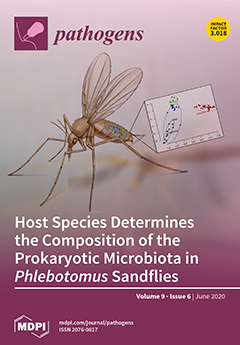Mycoplasma hyopneumoniae is the major pathogen causing enzootic pneumonia in pigs.
M. hyopneumoniae infection can lead to considerable economic losses in the pig-breeding industry. Here, this study established a first-order absorption, one-compartment model to study the relationship between the pharmacokinetics/pharmacodynamics (PK/PD) index of
[...] Read more.
Mycoplasma hyopneumoniae is the major pathogen causing enzootic pneumonia in pigs.
M. hyopneumoniae infection can lead to considerable economic losses in the pig-breeding industry. Here, this study established a first-order absorption, one-compartment model to study the relationship between the pharmacokinetics/pharmacodynamics (PK/PD) index of tilmicosin against
M. hyopneumoniae in vitro. We simulated different drug concentrations of timicosin in the fluid lining the lung epithelia of pigs. The minimum inhibitory concentration (MIC) of tilmicosin against
M. hyopneumoniae with an inoculum of 10
6 CFU/mL was 1.6 μg/mL using the microdilution method. Static time–kill curves showed that if the drug concentration >1 MIC, the antibacterial effect showed different degrees of inhibition. At 32 MIC, the amount of bacteria decreased by 3.16 log
10 CFU/mL, thereby achieving a mycoplasmacidal effect. The
M. hyopneumoniae count was reduced from 3.61 to 5.11 log
10 CFU/mL upon incubation for 96 h in a dynamic model with a dose of 40–200 mg, thereby achieving mycoplasmacidal activity. The area under the concentration-time curve over 96 h divided by the MIC (AUC
0–96 h/MIC) was the best-fit PK/PD parameters for predicting the antibacterial activity of tilmicosin against
M. hyopneumoniae (
R2 = 0.99), suggesting that tilmicosin had concentration-dependent activity. The estimated value for AUC
0–96 h/MIC for 2log
10 (CFU/mL) reduction and 3log
10 (CFU/mL) reduction from baseline was 70.55 h and 96.72 h. Four
M. hyopneumoniae strains (M1–M4) with reduced sensitivity to tilmicosin were isolated from the four dose groups. The susceptibility of these strains to tylosin, erythromycin and lincomycin was also reduced significantly. For sequencing analyses of 23S rRNA, an acquired A2058G transition in region V was found only in resistant
M. hyopneumoniae strains (M3, M4). In conclusion, in an in vitro model, the effect of tilmicosin against
M. hyopneumoniae was concentration-dependent and had a therapeutic effect. These results will help to design the optimal dosing regimen for tilmicosin in
M. hyopneumoniae infection, and minimize the emergence of resistant bacteria.
Full article






